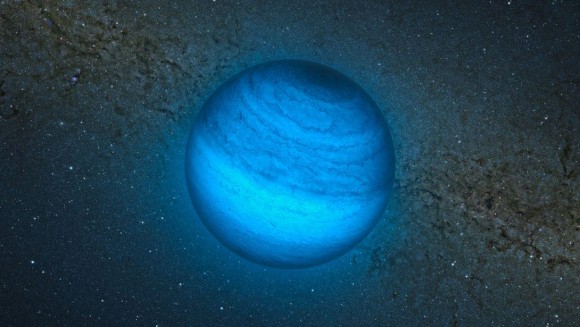New Rogue Planet Found, Closest to our Solar System
Want to stay on top of all the space news? Follow @universetoday on Twitter

The latest rogue world to be found is exciting in that it is the closest such object to our Solar System so far. At a distance of about 100 light-years, its comparative proximity, along with the absence of a bright star very close to it, has allowed the team to study its atmosphere in great detail. Astronomers say this object gives them a preview of the exoplanets that future instruments will be able to find – and potentially take image of — around stars other than the Sun. But the planet also seems to be loosely tied to a roving group of stars, called the AB Doradus Moving Group.
The new rogue planet, with the ungainly name of CFBDSIR J214947.2-040308.9 (CFBDSIR2149 for short), was found using the Very Large Telescope and the Canada-France-Hawaii Telescope. The astronomers, led by Philippe Delorme from the Institut de planétologie et d’astrophysique de Grenoble, CNRS/Université Joseph Fourier, France, are calling the object a rogue planet candidate for now, as they want to study it further to confirm its free-floating status.
Moving star systems are equally intriguing. The AB Doradus Moving Group is the closest such group to our Solar System, and the stars drift through space together in a pack. They are thought to have formed at the same time. If the new rogue planet actually is associated with this moving group, astronomers say it will be possible to deduce much more about it, including its temperature, mass, and what its atmosphere is made of. There remains a small probability that the association with the moving group is by chance.
The link between the new object and the moving group is the vital clue that allows astronomers to find the age of the newly discovered object. Without knowing its age, it’s not possible to know whether it is really a planet, or a brown dwarf, a “failed” star that lack the bulk to trigger the reactions that make stars shine.
This is the first isolated planetary mass object ever identified in a moving group, and the association with this group makes it the most interesting free-floating planet candidate identified so far.

This artist’s impression shows the free-floating planet CFBDSIR J214947.2-040308.9. Credit: ESO/L. Calçada/P. Delorme/Nick Risinger/R. Saito/VVV ConsortiumRogue planets – also known as free floating planets – are pretty intriguing. They are not orbiting a star but instead are wandering through the galaxy, having been either forcibly ejected from a solar system or having formed very early on in the Universe. While only a handful of these planets have been actually found, astronomers estimate these vagrant worlds could vastly outnumber stars. In fact, it’s been suggested there could be 100,000 times more rogue planets than stars in our Milky Way galaxy alone!
The latest rogue world to be found is exciting in that it is the closest such object to our Solar System so far. At a distance of about 100 light-years, its comparative proximity, along with the absence of a bright star very close to it, has allowed the team to study its atmosphere in great detail. Astronomers say this object gives them a preview of the exoplanets that future instruments will be able to find – and potentially take image of — around stars other than the Sun. But the planet also seems to be loosely tied to a roving group of stars, called the AB Doradus Moving Group.
The new rogue planet, with the ungainly name of CFBDSIR J214947.2-040308.9 (CFBDSIR2149 for short), was found using the Very Large Telescope and the Canada-France-Hawaii Telescope. The astronomers, led by Philippe Delorme from the Institut de planétologie et d’astrophysique de Grenoble, CNRS/Université Joseph Fourier, France, are calling the object a rogue planet candidate for now, as they want to study it further to confirm its free-floating status.
Moving star systems are equally intriguing. The AB Doradus Moving Group is the closest such group to our Solar System, and the stars drift through space together in a pack. They are thought to have formed at the same time. If the new rogue planet actually is associated with this moving group, astronomers say it will be possible to deduce much more about it, including its temperature, mass, and what its atmosphere is made of. There remains a small probability that the association with the moving group is by chance.
The link between the new object and the moving group is the vital clue that allows astronomers to find the age of the newly discovered object. Without knowing its age, it’s not possible to know whether it is really a planet, or a brown dwarf, a “failed” star that lack the bulk to trigger the reactions that make stars shine.
This is the first isolated planetary mass object ever identified in a moving group, and the association with this group makes it the most interesting free-floating planet candidate identified so far.

0 Comments:
Post a Comment
<< Home